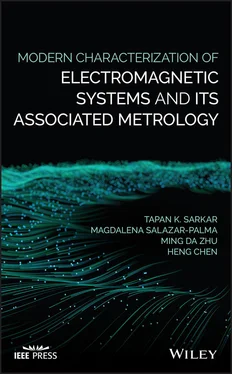1 ...6 7 8 10 11 12 ...18 The objective of this book is to advance the state of the art of antenna measurements and not being limited to the situation that measurements can be made in one of the separable coordinate systems just like the state of electromagnetics over half a century ago. We propose to carry out this transformation in the realm of measurement first by trying to find a set of equivalent currents just like we do in theory and then solve for these unknown currents using the Maxwell‐Hertz‐Heaviside equations via the Method of Moments popularized by Prof. Harrington. Since the expressions between the measured fields and the unknown currents are analytic and related by Maxwell‐Hertz‐Heaviside equations, the measurements can be carried out in any arbitrary geometry and not just limited to the planar, cylindrical or spherical geometries. The advantage of this new methodology as presented in this book through the topic “Source Reconstruction Method” is that the measurement of the fields need not be done using a Nyquist sampling criteria which opens up new avenues particularly in the very high frequency regime of the electromagnetic spectrum where it might be difficult to take measurement samples half a wavelength apart. Secondly as will be illustrated these measurement samples need not even be performed in any specified plane. Also because of the analytical relationship between the sources that generate the fields and the fields themselves it is possible to go beyond the Raleigh resolution limit and achieve super resolution in the diagnosis of radiating structures. In the Raleigh limit the resolution is limited by the uncertainty principle and that is determined by the length of the aperture whose Fourier transform we are looking at whereas in the super resolution system there is no such restriction. Another objective of this book is to outline a very simple procedure to recover the non‐minimum phase of any electromagnetic system using amplitude‐only data. This simple procedure is based on the principle of causality which results in the Hilbert transform relationship between the real and the imaginary parts of a transfer function of any linear time invariant system. The philosophy of model order reduction can also be implemented using the concepts of total least squares along with the singular value decomposition. This makes the ill‐posed deconvolution problem quite stable numerically. Finally, it is shown how to interpolate and extrapolate measured data including filling up the gap of missing measured near/far‐field data.
The book contains ten chapters. In Chapter 1, the mathematical preliminaries are described. In the mathematical field of numerical analysis, model order reduction is the key to processing measured data. This also enables us to interpolate and extrapolate measured data. The philosophy of model order reduction is outlined in this chapter along with the concepts of total least squares and singular value decomposition.
In Chapter 2, we present the matrix pencil method (MPM) which is a methodology to approximate a given data set by a sum of complex exponentials. The objective is to interpolate and extrapolate data and also to extract certain parameters so as to compress the data set. First the methodology is presented followed by some application in electromagnetic system characterization. The applications involve using this methodology to deembed device characteristics and obtain accurate and high resolution characterization, enhance network analyzer measurements when not enough physical bandwidth is available for measurements, minimize unwanted reflections in antenna measurements and, when performing system characterization in a non‐anechoic environment, to extract a single set of exponents representing the resonant frequency of an object when data from multiple look angles are given and compute directions of arrival estimation of signals along with their frequencies of operation. This method can also be used to speed up the calculation of the tails encountered in the evaluation of the Sommerfeld integrals and in multiple target characterization in free space from the scattered data using their characteristic external resonance which are popularly known as the singularity expansion method (SEM) poles. References to other applications, including multipath characterization of a propagating wave, characterization of the quality of power systems, in waveform analysis and imaging and speeding up computations in a time domain electromagnetic simulation. A computer program implementing the matrix pencil method is given in the appendix so that it can easily be implemented in practice.
In numerical analysis, interpolation is a method of estimating unknown data within the range of known data from the available information. Extrapolation is also the process of approximating unknown data outside the range of the known available data. In Chapter 3, we are going to look at the concept of the Cauchy method for the interpolation and extrapolation of both measured and numerically simulated data. The Cauchy method can deal with extending the efficiency of the moment method through frequency extrapolation. Interpolating results for optical computations, generation of pass band using stop band data and vice versa, efficient broadband device characterization, effect of noise on the performance of the Cauchy method and for applications to extrapolating amplitude‐only data for the far‐field or RCS interpolation/extrapolation. Using this method to generate the non‐minimum phase response from amplitude‐only data, and adaptive interpolation for sparsely sampled data is also illustrated. In addition, it has been applied to characterization of filters and extracting resonant frequencies of objects using frequency domain data. Other applications include non‐destructive evaluation of fruit status of maturity and quality of fruit juices, RCS applications and to multidimensional extrapolation. A computer program implementing the Cauchy method has been provided in the Appendix again for ease of understanding.
The previous two chapters discussed the parametric methods in the context of the principle of analytic continuation and provided its relationship to reduced rank modelling using the total least squares based singular value decomposition methodology. The problem with a parametric method is that the quality of the solution is determined by the choice of the basis functions and use of unsuitable basis functions generate bad solutions. A priori it is quite difficult to recognize what are good basis functions and what are bad basis functions even though methodologies exist in theory on how to choose good ones. The advantage of the nonparametric methods presented in Chapter 4is that no such choices of the basis functions need to be made as the solution procedure by itself develops the nature of the solution and no a priori information is necessary. This is accomplished through the use of the Hilbert transform which exploits one of the fundamental properties of nature and that is causality. The Hilbert transform illustrates that the real and imaginary parts of any nonminimum phase transfer function for a causal system satisfy this relationship. In addition, some parametrization can also be made of this procedure which can enable one to generate a nonminimum phase function from its amplitude response and from that generate the phase response. This enables one to compute the time domain response of the system using amplitude only data barring a time delay in the response. This delay uncertainty is removed in holography as in such a procedure an amplitude and phase information is measured for a specific look angle thus eliminating the phase ambiguity. An overview of the technique along with examples are presented to illustrate this methodology. The Hilbert transform can also be used to speed up the spectral analysis of nonuniformly spaced data samples. Therefore, in this section a novel least squares methodology is applied to a finite data set using the principle of spectral estimation. This can be applied for the analysis of the far‐field pattern collected from unevenly spaced antennas. The advantage of using a non‐uniformly sampled data is that it is not necessary to satisfy the Nyquist sampling criterion as long as the average value of the sampling rate is less than the Nyquist rate. Accurate and efficient computation of the spectrum using a least squares method applied to a finite unevenly spaced data is also studied.
Читать дальше












